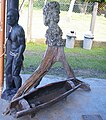Lali (drum)
The lali is a percussion idiophone made from a trunk wood , according to its shape a trough drum that is counted among the hollow slit drums, which occurs in several variants on the Fiji islands and neighboring islands in western Polynesia and which, depending on its size, is played as a signaling instrument or to accompany a dance .
The church service is called with the lali , which is over two meters long . The smaller, portable lali ne meke is used to accompany singing and dancing, its opening is held against the chest to reinforce the resonance. In terms of shape and use, it corresponds to the lali faiva in Tonga . In Samoa , lali is one meter in length and is the medium-sized of several slit drums.
Form and function
The lali is related to the hollow slit drums of the Maori in New Zealand and peoples in Polynesia. Traditionally, the lali was an important object of Fijian culture, used as a communication tool to announce births, deaths and war. A smaller form, the lali ni meke , is used for making music. The lali is used today to call people together, e.g. B. to worship. As a folklore instrument, it is used to entertain guests in hotels. The lali is played with the hands or with sticks ( i uaua ), which are made of softer wood so as not to damage the instrument. In the past, the lali was played with a larger and a smaller stick.
Lali are traditionally made from hardwood logs. Portable war drums ( lali ni valou ) had two or three resonance chambers and could produce complex sounds.
Often lali were played as a pair of instruments of different sizes. Great lali are often played by two drummers who differ in rhythm.
literature
- Chris Thomüson Saumaiwai, Mervyn Mc Lean, Jeremy Montagu: Lali. In: Laurence Libin (Ed.): The Grove Dictionary of Musical Instruments Vol. 5. Oxford University Press, Oxford / New York 2014, pp. 245f
Web links
- Video with two drummers
- Drummers with Lali (historical picture)
- Drummers with Lali-ni-Meke dance drum (historical picture)
- Pahu log drum from New Zealand
Footnotes
- ↑ Ruth Midgley (ed.): Musical instruments of the world . Prisma, Gütersloh 1981, p. 116, ISBN 3-570-05576-0
- ↑ Ewins, R. 1982. Fijian Artefacts; Tasmanian Museum and Art Gallery Collection.
- ↑ Clunie, F. 2003. Yalo-i-Viti: A Fiji Museum Catalog, page 54




